Agritourism can provide critical supplemental income for farmers. But navigating regulations is a mixed bag.
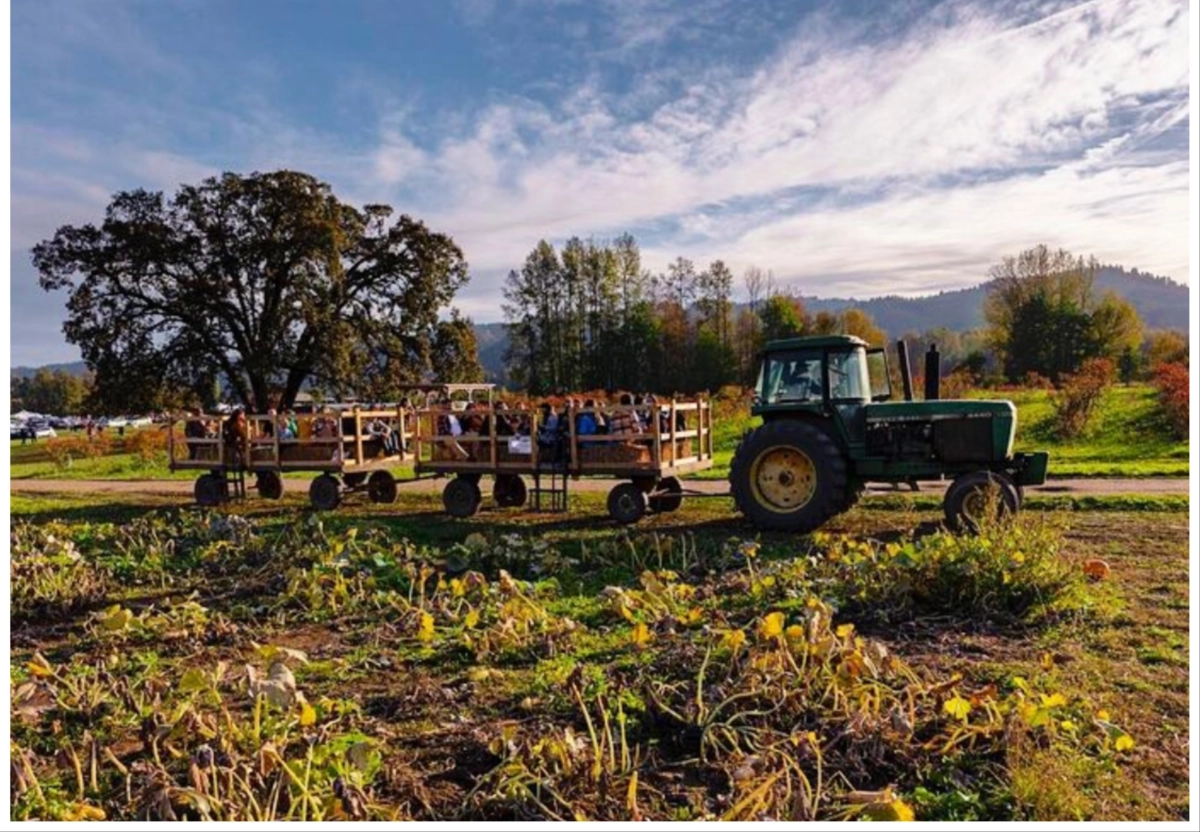
Visitors to Topaz Farm on Sauvie Island just outside of Portland, Oregon last October didn’t encounter a corn maze but rather a kid’s maze cut through a field of sorghum. It’s easier on the soil, explains Kat Topaz, who owns the farm along with Jim Abeles. Topaz and Abeles put up a sign explaining the choice, and they frequently take the opportunity to explain their farming decisions to visitors.
“We call ourselves an ‘experience farm,’” says Topaz. “But we could just as easily call ourselves an educational farm.”
Topaz Farm grows vegetables, berries and more—but it also participates in something called agritourism, a broad term that includes activities and events that bring visitors to the farm. This relationship between the farm and the greater community has been critical to the farm’s survival over the past few years.
When Abeles and Topaz first acquired their land on Sauvie Island, it had been conventionally farmed for decades and had “virtually nothing good in the soil,” says Topaz. As they began to farm the land, they also endeavored to learn about regenerative techniques to foster healthier soil—supplementing with microbes, biochar and more. But these things don’t transform soil overnight, and in the meantime, it was difficult to make enough income through traditional farming alone. This was coupled with other mishaps that often befall small farms. The first year, deer ate two acres of strawberries while Topaz and Abeles were sleeping. This past year, squash bugs helped wipe out their pumpkin crop. Their forays into agritourism have kept the farm afloat.
“We think that for farmers to become sustainable financially and to remain in business and to keep farming, they have to have the flexibility to have diverse revenue sources,” says Abeles.
They aren’t the only ones who feel this way. When announcing the results from the 2022 Census of Agriculture this February, Secretary of Agriculture Tom Vilsack said that many farmers rely on off-farm income to keep their production afloat, and he supports diversifying farmers’ income streams to keep farming economically feasible, although he didn’t mention agritourism specifically.
But despite many farms depending on extra revenue, which agritourism can provide, farmers such as Topaz and Abeles face challenges in navigating agritourism laws. According to Oregon’s legal code, farms can have “farm stands” as long as no more than 25 percent of the sales are attributable to “incidental items and fees from promotional activity.” This includes some but not all aspects of agritourism. But it doesn’t always make sense to Topaz and Abeles what fits into which category—it’s a problem, since there’s a hard cap on incidentals. For example, if they sell tickets to a farm dinner and prepare guests food made from the produce harvested on the farm, this can’t exceed 25 percent of their “farm stand” income.
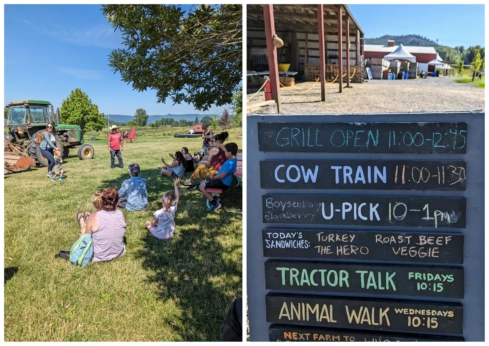
Left: At Topaz Farm, as with many agritourism farms, education is a key component. Right: A sign listing some agritourism activities visitors can participate in. (Photography by Topaz Farm)
Other issues emerged. They were told by a county official that if they host live music, it can’t be called a concert. But it is OK to call it a “harvest festival featuring a live music performance.” If a class of school children comes to the farm for an educational field trip and it’s raining (as it often does in northwest Oregon), Abeles and Topaz want to be able to utilize tents, but the county has flagged this as an issue as well, with the outcome yet to be decided.
“We used to say Mother Nature was the most challenging part of farming,” says Topaz. “We’ve replaced that with Multnomah County and the state being the most difficult thing that we deal with. And we’re not alone.”
The immense counterweight to all of these restrictions is that land use laws are in place for a reason: to protect the integrity of farmland. Across the country, millions of acres of farmland have been lost over the last 30 years, due to development and other forms of land conversion. What farmers, conservationists, lawmakers and residents of Oregon and the rest of the country are faced with is a delicate dilemma: How do you preserve the integrity of the country’s best farmland without sacrificing the livelihood of the farmer in the process?
Agritourism on the farm
“Agritourism” is an umbrella term that encompasses so many different things. The National Agricultural Law Center defines agritourism as the “crossroads” of agriculture and tourism; it draws visitors to farms for educational, entertainment or recreational purposes, and it is intended to increase farm income. Examples vary widely; corn mazes, on-farm markets, farm stays and bed and breakfasts, U-pick opportunities, farm-to-table dinners, tours and classes are all examples of agritourism, and there are a lot more, too.
This breadth is a double-edged sword. On one hand, there are a lot of different and customizable opportunities to bring in extra income on farms. But, at the same time, regulating all of these different activities as a monolith doesn’t make sense. As a result, the type of agritourism a farm can practice and how much of the business it can be isn’t consistent, not just state to state, but even county to county.
“There is not one nationally or internationally recognized definition,” says Audrey Comerford, an agritourism coordinator at Oregon State University Extension. “Which means it’s kind of an amoeba … [It] encompasses a lot of different things depending on the location.”
Comerford co-authored a new economic impact report on agritourism in Oregon’s Willamette Valley. Of the 18,679 farms in the Willamette Valley, about 4,000 of them may be engaged in some kind of agritourism. For these farms, agritourism can account for as much as 50 percent of their business.
Comerford says Oregon’s land use laws seem to be stricter than those in other places in general. A national survey from the University of Vermont echoes this point, finding that farmers on the West Coast listed legal regulations as one of their biggest hurdles to agritourism.
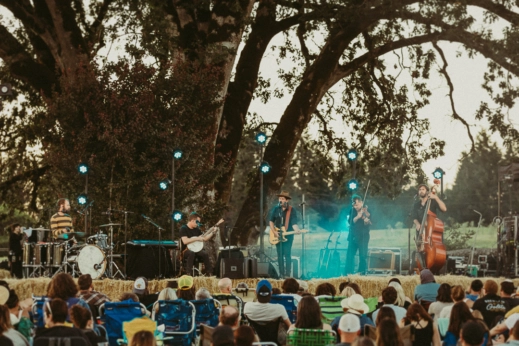
Live music featuring Gregory Alan Isakov at Topaz Farm. (Photography by Sara Wright)
The idea of gathering on farms is not new, says Lisa Chase, director of the Vermont Tourism Research Center at the University of Vermont and lead author of this survey. That’s something that’s been around as long as we’ve had agriculture. The more recent development is the profound disconnect between most people and the farms that feed them—direct on-farm jobs accounted for less than 2 percent of US employment in 2022.
“What’s new is this disconnect with agriculture, for almost all of the US population, and that provides an opportunity for farms to help the non-farming public learn about food production, and [it] also provide some additional income for the farms,” says Chase.
In this way, agritourism provides an opportunity to increase the “agricultural literacy” of the public. But agritourism is a term that should be only reserved for working farms, says Chase. Unfortunately, that’s a tough thing to quantify.
“The fact that it’s a working farm needs to be included, and then it becomes a question of how do you measure that,” says Chase.
In Oregon, farmers such as Abeles and Topaz of Topaz Farm have to carefully navigate the rule that only 25 percent of their farm stand income can come from “incidental items” and “fees from promotional activity.” Another approach would be to use time spent or labor percentage instead of income, says Chase—something she’s seen in Italy. The benefit of this method is that these incidentals, such as farm stays or farm dinners, earn more over less time. This approach limits the amount of time spent devoted to agritourism, instead of capping the portion of income that is derived from it.
“It became problematic for farms who could make so much money from their overnight farm stays and not as much money from the food they were producing, even though it was a legitimate working farm,” says Chase.

A farm to table dinner at Topaz Farm. (Photography by Topaz Farm)
Even though this is a hard thing to try to quantify, getting it right is paramount. Chase says that, not too long ago, she had a phone call from a developer who was talking about starting an agricultural theme park and was curious about agritourism. Chase advised them that they shouldn’t use that word if they weren’t going to be running a working farm.
“This is exactly what people are worried about,” says Chase. “As agritourism grows in popularity, it is a real concern. And the core of agritourism is that you’re a working farm. And I think that is what needs to be maintained in the regulations.”
‘Exclusive farm use’
Protecting farmland from losing its working farms is a key concern for Greg Holmes, Working Lands Program Director/Southern Oregon Advocate for 1000 Friends of Oregon, an organization that advocates for land-use planning.
Oregon passed Senate Bill 100 in 1973, creating the Department of Land Conservation and Development. This legislation and subsequent entity became the framework for land use protections in Oregon and, over the last 50 years, has protected much of Oregon’s fertile farmland (as well as forest land and conservation land) by labeling it as “exclusive farm use.”
While the state creates the regulations, it’s up to individual counties to zone the land. This can create some confusion, but the differentiation is essential. The land and the ecosystems it supports vary drastically throughout the state, from the damp, fertile Willamette Valley in the northwest corner of the state to the arid high desert of the eastern half of Oregon down to the piney shared border with California. Zoning all of these counties as though they are the same would come with its own problems. On top of this county-to-county variation, soil suitable for farmland is defined slightly differently for the west side of the Cascade Range versus the east side.
“There [is] various room for interpretation and different counties apply the regulations, as they understand them, slightly differently,” says Holmes. “The result is that every county has something that fits the definition of exclusive farm use. And it’s protected and zoned for the purpose of protecting agriculture.”
Under Oregon’s legal code, if a farm on exclusive farm use land has a farmstand, income generated from the “incidental” items or “fee-based activity” sold there must be no more than 25 percent of the total farm stand revenue. Agritourism does not fall neatly into this split. For example, U-pick offerings don’t count toward the 25 percent, but tickets to a farm-to-table dinner do. The point is to prevent abuse of farmland—for example, selling things at a farmstand that don’t have anything to do with farming.
“The point of the limitation on the incidental sales is they want to make sure that it remains a farmstand and doesn’t have a store that happens to be located on agricultural land and is drawing people to it,” says Holmes.
A better definition of agritourism, says Holmes, would help draw a cleaner line between working farms making supplemental income and other types of businesses trying to use a farmscape as their setting. It has to address both the tourism aspect and the direct tie to working agriculture.
“The cleanest way to do this would be to start from the beginning,” says Holmes, to define what counts as acceptable agritourism and what should not take place on agricultural land. From there, the law can clarify the process of how to permit acceptable activities. “I don’t think you can ever get a list that’s all-encompassing, but we can do a lot better than what we’ve done now.”
Defining agritourism
Holmes isn’t the only one who has identified the need for a more concrete definition of agritourism. Suzi Spahr, executive director for NAFDMA, an organization that unites agritourism operators, says there’s significant diversity in what agritourism is.
“You will have many local governments or state government officials who will think that they know what a particular farm will do and then will want to make regulations based on that style,” says Spahr. “But you’ll have a variety of different agritourism operations, and so a one-size-fits-all all very frequently does not fit the industry to its best.”
NAFDMA has created its own definition of agritourism: “Agritourism is an agricultural enterprise attracting visitors to a farm or ranch to experience a connection with agriculture production and/or processing through entertainment, education, and/or the purchase of farm products.”
“We are starting to use that as sort of the basis by which we ensure that the focus remains on agriculture as the main guiding force, the main purpose behind what’s occurring,” says Spahr.
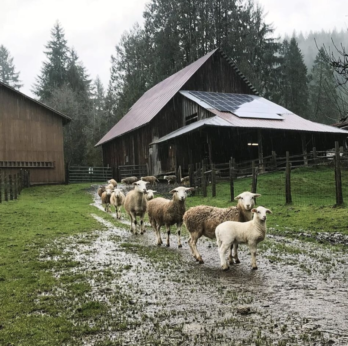
Sheep at Leaping Lamb Farm. (Photography by Nathan Fussell)
Scottie Jones of Leaping Lamb Farm in Alsea, Oregon practices a type of agritourism where guests can come stay on her farm. Jones found that having an overnight rental on her farm greatly increased the viability of her business.
“It’s horrible to say this, but, you know, it takes the agritourism for me to be able to be a successful farmer,” she says.
She keeps the farm at the center of the farm stays—she loves the questions from guests that she gets to answer—what does a potato look like in the ground? What is a fertilized egg? Jones says it’s an opportunity for connection.
“We sell lamb—that’s our prime agricultural product that we sell,” says Jones. “But by adding the farm stay, immediately, we were starting to be able to pay for the tractor to break down, and we weren’t using our retirement to be farmers. So, I was wholly invested in what this could do for us; also what it could do for the people that came to visit.”
Jones is also the chair for North America at the Global Agritourism Network and the owner/operator of Farmstay, a network of small overnight rentals on farms across the country. It offers support and resources for farmers looking to diversify their business this way. Jones has also seen some of the abuses of this pathway—hotels or developers trying to create luxury agricultural stays on farmland.
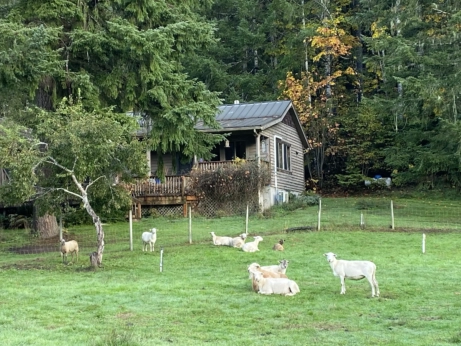
The farm stay at Leaping Lamb Farm. (Photography by Leaping Lamb Farm)
“Farmstay is about working farms and ranches that offer lodging,” says Jones. “So, it’s about going onto a real farm. It’s not a fake farm, it’s not a beautiful piece of property; it’s a working farm.”
She sees these “fake farm” businesses as a detriment to trying to figure out how to proceed with legislation making agritourism easier on actual farms.
“I do understand the fear there,” says Jones. “I just need our regulators to know that there’s the rest of us. There’s the rest of us out there, just really trying to make a dollar and really wanting to make that connection and really wanting to provide a place for people to come to the country and learn something.”
***
Interested in figuring out if agritourism is right for your farm? Audrey Comerford co-teaches this online on-demand course for producers in Oregon. The OSU Extension Agricultural Tourism website can be found here, and you can sign up for its quarterly newsletter here. The Vermont Tourism Research Center has an extensive catalog of resources. Farmstay helps farmers looking to host guests figure out how to get started. And NAFDMA is a central resource hub for North American agritourism enterprises.
Want to learn more about land protections? Read more on the 1000 Friends of Oregon website. Here, you can learn more about Oregon’s land use planning system, read impact reports and brief yourself on important bills in Oregon’s 2024 legislative session.

I bought abandoned farm land in Yamhill County, Oregon in 2019. The land was choked with noxious weeds, such as Himalayan Blackberry. I cleared the land and developed productive pastures. Income from farming is so low and County regulations are so restrictive regarding agritourism, that I’m pushed to abandon the farm and look for off farm employment to support my family. I’m afraid I’ll be too busy off farm earning a living to stop the ever present threat of blackberry invasion. Since my farm income from selling sheep isn’t sufficient and selling sheep “experiences” is illegal, the productive farmland I’ve… Read more »
Very interesting article thank you for the information!